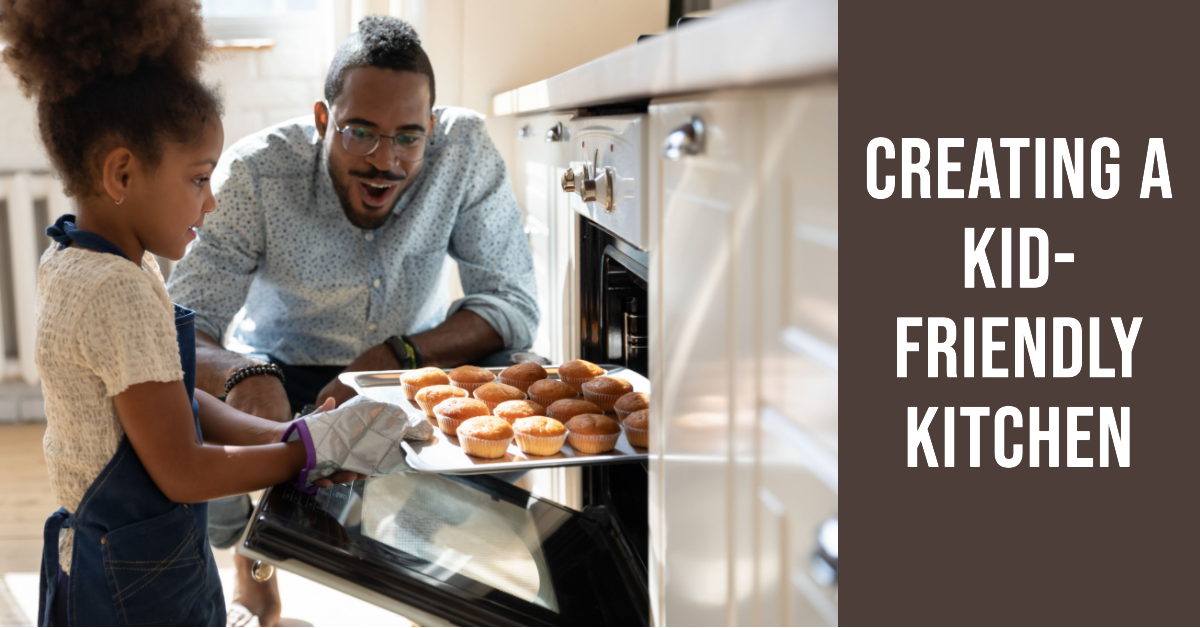I am a well-rounded expert with proficiency in several fields. My experience spans from being a dedicated chef and homemaker. As a passionate homesteader, I’ve honed my skills in sustainable living and animal care, ensuring a holistic approach to everything I undertake. Email me or Txt: (# removed due to spam, please email)
A kid-friendly kitchen is not only a safe and enjoyable space for children, but it also provides an excellent opportunity for them to learn about cooking and develop healthy eating habits.
In this article, we’ll discuss how to design a kid-friendly kitchen space and involve children in meal preparation while fostering a lifelong appreciation for cooking and nutrition.

Designing a Safe and Kid-Friendly Kitchen Space
Choosing Age-Appropriate Kitchen Tools and Equipment
To create a safe and engaging environment for children, consider investing in age-appropriate kitchen tools and equipment.
Child-safe knives and cutting boards allow kids to practice essential cutting skills without the risk of injury.
Non-slip mixing bowls and utensils help prevent spills and accidents during meal preparation.
Step stools offer easy access to countertops and cabinets, empowering children to be more independent in the kitchen.
Some kitchen appliances should never be operated by a child, Such as an electric mixing bowl or blender without parental supervision.
Creating a Dedicated Workstation for Kids
A dedicated workstation for kids is essential in fostering their interest in cooking.
Adjustable work surfaces that can be modified according to a child’s height make it easier for them to reach ingredients and tools.
Accessible storage areas for kid-friendly tools and equipment encourage children to take ownership of their kitchen space and feel more confident in their cooking abilities.
Implementing Safety Measures
Safety is paramount when designing a kid-friendly kitchen. Install safety latches on cabinets and drawers to keep dangerous items, like cleaning products and sharp utensils, out of reach.
Use appliance covers and guards to prevent accidental burns or injuries from hot surfaces and moving parts.
Keep unused appliances unplugged at all times, Especially loss-of-limb appliances such as blenders and food processors.

Encouraging Participation in Meal Preparation
Assigning Age-Appropriate Tasks
Involving children in meal preparation helps them develop essential cooking skills and fosters a sense of accomplishment.
Assign age-appropriate tasks like peeling and washing vegetables, stirring and mixing ingredients, or measuring and pouring liquids.
These activities not only boost their confidence but also provide opportunities to learn about ingredients and their functions in a recipe.
Building Cooking Skills Progressively
Start with simple recipes that allow children to master basic cooking techniques before moving on to more complex dishes.
Gradually introduce new skills and techniques as they become more comfortable and confident in the kitchen.
This progressive approach helps kids build a strong foundation in cooking and makes the learning process enjoyable and rewarding.
Making Cooking Fun and Engaging
Keep children interested in cooking by making it a fun and engaging activity. Organize theme nights, such as “Taco Tuesday” or “Make-Your-Own-Pizza Night,” or introduce cooking challenges that encourage creativity and experimentation.
These activities not only make meal preparation enjoyable but also provide opportunities for kids to explore different cuisines and ingredients.

Fostering Healthy Eating Habits
Involving Children in Meal Planning and Grocery Shopping
Teach children about different food groups and the importance of a balanced diet by involving them in meal planning and grocery shopping.
Encourage them to choose healthy ingredients and to be aware of the nutritional value of the foods they eat.
Show them how to determine what’s in a package food by reading the ingredients list. Make it a fun game of learning what those ingredients actually are.
This hands-on approach helps kids develop an understanding of the relationship between food and health.

Educating Kids About Nutrition and the Importance of a Balanced Diet
Discuss the benefits of various foods and their impact on health with your children.
Explain the importance of consuming a balanced diet, including fruits, vegetables, whole grains, lean proteins, and healthy fats.
This knowledge empowers kids to make informed decisions about the foods they eat and helps them develop a strong foundation for lifelong healthy eating habits.

Encouraging Mindful Eating and Portion Control
Teach children to listen to their bodies and recognize when they are hungry or full.
Encourage mindful eating by slowing down the pace of meals and focusing on the flavors and textures of the food.
Practice proper serving sizes and portion control to help kids develop an understanding of appropriate food consumption and maintain a healthy weight.
These habits, when established early, can contribute to a lifetime of mindful eating and better overall health.

A Greater Understanding of the Human Digestive Process
A better understanding of how humans use food is crucial for making informed decisions about our diets and overall health.
The human digestive process is a complex system that breaks down food, absorbs nutrients, stores energy and eliminates waste products.
By exploring the different stages of digestion and the roles of various organs, we can gain valuable insights into the importance of proper nutrition and the impact of our food choices on our well-being.

Conclusion
Creating a kid-friendly kitchen and involving children in meal preparation are essential steps in fostering a lifelong love for cooking and healthy eating habits.
By designing a safe and engaging kitchen space, assigning age-appropriate tasks, and making cooking fun, you can encourage your little ones to develop essential skills and knowledge about food and nutrition.
Involving them in meal planning, grocery shopping, and teaching them about the importance of a balanced diet and mindful eating further instills a strong foundation for lifelong health and well-being.




